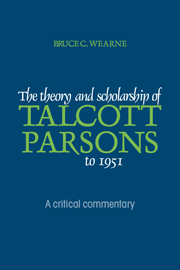Book contents
- Frontmatter
- Contents
- Preface
- Part 1 Unravelling Talcott Parsons' theoretical development
- Part 2 Talcott Parsons: the roots of his thought
- Part 3 The development of theory
- Part 4 The theory
- 7 Conceptualizing The Social System
- 8 Developing The Social System
- 9 Formulating The Social System
- 10 The Social System
- Part 5 Parsons' theory as it stood at 1951
- Appendix Some recent publishing on Talcott Parsons' theory: a bibliographical essay
- List of references
- Index of names
- Index of Parsonian concepts
8 - Developing The Social System
Published online by Cambridge University Press: 05 February 2012
- Frontmatter
- Contents
- Preface
- Part 1 Unravelling Talcott Parsons' theoretical development
- Part 2 Talcott Parsons: the roots of his thought
- Part 3 The development of theory
- Part 4 The theory
- 7 Conceptualizing The Social System
- 8 Developing The Social System
- 9 Formulating The Social System
- 10 The Social System
- Part 5 Parsons' theory as it stood at 1951
- Appendix Some recent publishing on Talcott Parsons' theory: a bibliographical essay
- List of references
- Index of names
- Index of Parsonian concepts
Summary
Background: 1937–51
The aim of this chapter is to trace Parsons' systematic point of view as it unfolded. Whilst I do not want to suppress important aspects of Parsons' biography, it is sufficient to note the problem of keeping exclusively to the theoretical side of things.
Did Vilfredo Pareto's influence upon Parsons progressively diminish during this time? In The Structure Parsons had worked with an explanation of his methodological self-consciousness, which he said was derived from Pareto; as he had pointed out it was not a matter of repudiating Pareto, but of building on his conception of the social system (T. Parsons 1937a: 460). Pareto had represented something of a fad at Harvard in the 1930s (T. Parsons and B. Barber 1948: 254), yet when Pareto's system was no longer in vogue Parsons maintained deep respect for his achievement, keeping him in mind when writing the Preface to The Social System.
The title, The Social System, goes back more than to any other source, to the insistence of the late Professor L J Henderson on the extreme importance of the concept of system in scientific theory, and his clear realization that the attempt to delineate the social system as a system was the most important contribution of Pareto's great work. This book therefore is an attempt to carry out Pareto's intention, using an approach, the ‘structural-functional’ level of analysis, which is quite different from that of Pareto …
(T. Parsons 1951: vii)- Type
- Chapter
- Information
- The Theory and Scholarship of Talcott Parsons to 1951A Critical Commentary, pp. 116 - 132Publisher: Cambridge University PressPrint publication year: 1990



